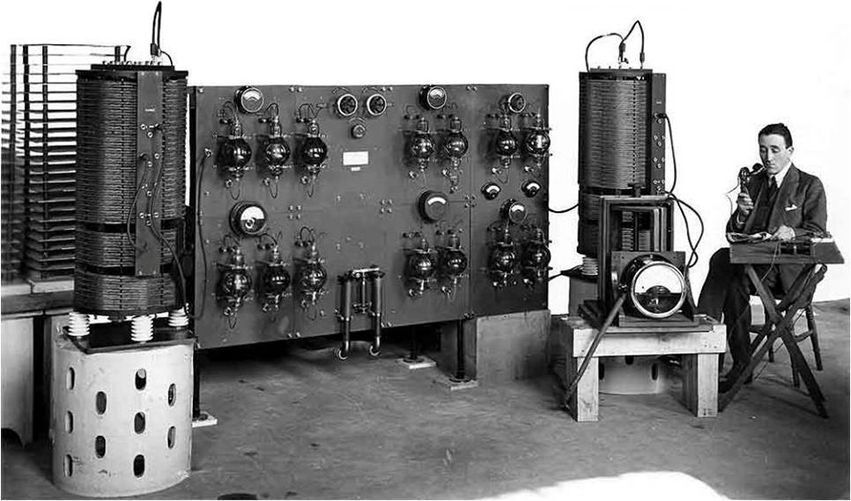9 Likes
1 Comments
1 Shares

The first broadcast transmitter operated in Great Britain, installed at the Marconi Works, Chelmsford, in 1919 and 1920.

May 13, 1946, the Federal Communications Commission (FCC) granted Southwestern Bell a license for radio-telephone service, which enabled those in St. Louis to be the first in the nation to make and receive phone calls in their car.
Covering a 75-mile radius of downtown calls to an auto had to be placed through a mobile operator at 2654 Locust. This was transferred over normal telephone lines to the office at 1010 Pine, where the call went out over VHF radio from the 250-Watt transmitter on the building's roof.
Service cost $15 a month, after a $25 installation fee. There was an additional charge per call, depending on time. As seen in this photo, necessary equipment took much of the trunk space. The first radiotelephone call was placed in St. Louis on Jun 17, 1946.
[sources: John Sarkis & Missouri Life]

The world’s first television remote control. The wireless “Flash-Matic" was invented by Zenith engineer Eugene Polley in 1955.

Mixing ‘Friday Night Is Music Night’ at the Camden in 1965. Photo: BBC
This Camden Theatre installation was the only Pye console in BBC Radio, put in in the 1960s. Note all those empty Mic Amp sections on the right hand side in this picture.
“The Pye console was built in a semi-circular format and had four 8-channel groups and four independent channels. Each set of 8 channels was separated from the next by a wedge-shaped spacer; a centre section housed the group and independent faders. The master fader was a large rotary knob, with a second identical one alongside designated as the standby output. The faders were quadrant type, and worked in the opposite sense to those in the commercial studios of the day, fading up towards the operator. This enabled the fader graduations towards the open end to be seen, as the curvature of the faders meant that the operator could not see the other end. Line up, with 10dB in hand, was stop 23; the graduations went from 0 to 30 but in a linear manner. There were two associated rotary controls for each fader, echo send and PA send. The echo control was a dual log/antilog potentiometer providing echo mixture in a similar way to the standard BBC echo mixture switch but continuously variable. This was later used as a pan pot when the desk was adapted for stereo, which was simply done merely by using the echo send. Each channel had its own RSA – Response Selection Amplifier – the BBC term for what was known elsewhere (inaccurately) as an equaliser, and there were several (four?) compressor/limiters which could be patched into channels or groups. There were two enormous jackfields, one at each end of the console built into the ends of the semicircle."
“The electronics were based on germanium transistors, which were highly sensitive to overheating. The console was cooled by a forced air system with the fan unit in the corridor outside the cubicle. A large orange lamp indicated that all was well, and it was rumoured that if the fan failed and the lamp went out we had about 30 seconds to power the desk down before it melted in a mini China Syndrome! The transistorised electronics was also quite noisy, with a very small margin between overload and excessive noise, and there were strict instructions about the permitted usable range of the main fader, which was about 10dB!”
“For audio monitoring, two loudspeakers were provided – an LSU10 for the Popular Music SMs and an LS5-1 for the Light Music SMs. Due to the large size of the cubicle it was difficult to achieve a satisfactory listening level with either of these units so they were often used together by the Pop Music SMs. To ensure that any distortion was not caused by loudspeaker overload the practice was to send tone at PPM6, set the desk LS control to maximum and turn up each LS gain control in turn until distortion occurred, then back it off a little. That was quite loud!”
Music to dig through old code as the afternoon moves on.
https://invidious.nerdvpn.de/watch?v=0iWwOaj99SI
#reka #hörberlin #ebm #electronics #synthwave #techno
Later that day. Electrons in the mind, Italo-Disco-Revival edition.
https://invidious.nerdvpn.de/watch?v=egUkoZ5Gvx4
#pablobozzi #ritmofatale #electronics #2020s
Welcome to 2023 - Your Ikea "MARKUS" chair is not compatible with your screen 👏🤦♂️
#ikea #hardware #electronics
Another thing to consider!
https://ohai.social/@haeckerfelix@mastodon.social/110272445090398089
Music for wrestling infrastructure.
https://invidious.nerdvpn.de/watch?v=Q5I6BjP5cTc
#melaniehavens #hörberlin #ebm #electronics
Music for waking up, music for early work.
https://invidious.nerdvpn.de/watch?v=h7gRK4cQcvY
#roüge #techno #electronics
Reality Check: ROÜGE x NDE94 (Audiovisual Experience)
https://www.youtube.com/watch?v=3lDEQNQdvB4

Time to "go back to school" and build some WiFi units for my hydroponic systems so I can control them from the phone, I know it is easier said than done but I need something to tickle my brain now.